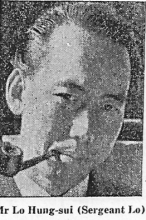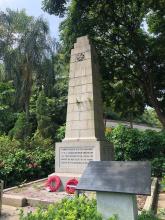Get Gwulo's books
Directory
Click on your area of interest to choose from over 30,000 pages about old Hong Kong:
- Images & photos
- View - View galleries - View new - Create - Forum topics
- View - Create - Places & buildings
- View map - View new - Create - Streets
- View map - View new - Create - People
- View - View new - Create - Organisations
- View all - View new - Create - Diaries & memoirs
- View - View new - Create diary - Create page - Events
- View - View new - Create - Jurors lists
- View - Type a page
Or choose a popular article:



Comments
Lo Hung-sui, BAAG.
From the entry for Lo in the BAAG Personnel Register, Ride Collection:
Nationality Chinese, born Canton 1916, Newspaper reporter, BAAG May 42 - Dec 45. Recommendation of award for the King's Medal for courage in the Casue of Freedom:
“The man was a sergeant in the HKVDC, and served throughout the hostilities in Hongkong; after the surrender he evaded capture and made his way to Free China to continue his service to the Crown. He joined the BAAG immediately and was forthwith employed as contact man for the Bankers in Hongkong who were being compelled to work for the enemy. He made the hazardous trip to Hongkong a number of times, knowing his capture would mean certain death, and then planned and carried out personally the successful escape of two Bankers - Fenwick and Morrison - who were urgently wanted in London. In 1943, he was again operating inside Hongkong but later was withdrawn and sent to carry out a field reconnaissance of the enemy-occupied area on the West banks of the Canton Delta. He spent about a month in this area and returned with most valuable sketches, photographs and reports.
In all his work, he has always displayed a high level of courage and with military training above the average his reports have always been most accurate and valuable.” (signed) L T Ride, Colonel. 1946.
From an audio tape by L T Ride, 1976.
When the Japanese got all the prisoners of war locked up in the camps, they then interned all the British civilians on the Stanley Peninsula with the exception of the staff of the Hongkong and Shanghai Bank. They were all pushed into filthy Chinese hotels, brothels really, along Connaught road. One of the problems obviously was to try to find out what the Japanese game was.
By this time the bankers knew that there was an organisation such as ours working outside, and eventually they managed to get a message out to Duggie [Clague] asking whether he could get a message through to the number one of the Hongkong and Shanghai in Bank in New York advising him to prepare for a loss of about eight million. This was a very difficult situation to be faced with, for my military instructions did not cover a situation such as this. The alternatives were to send a runner with a special despatch by road to Chungking, but time was against that. We had no wireless, or permission to use code over the telegraph. Open telegraph was terribly slow – besides which the whole of South and West China would know the contents as soon as Chungking. My experience already was that overseas cable was quicker than any other method, and it was the one which I ultimately used (I had to deal with the raspberry when it came a few months later).
To solve the problem we had to mount what in the end was one of our most interesting and successful operations.
Duggie had on his staff at the time a former Chinese member of the H.K.V.D.C. named Lo. He was a bit of a lone wolf and liked working on his own, just the sort of chap for a job like this.
The plan was that he should go into Hongkong and make contact with the Bankers, who were being taken by the Japanese every day from their hotel to their work at the Bank on some special job. The job was this: before the war all Hongkong and Shanghai banknotes were actually signed by members of the staff – they weren’t just stamped as they are nowadays – and this is what the Japanese had the Bank staff doing because when the Japanese took over the Bank they found the vaults stacked with unsigned notes, all money for jam. It was realised how valuable it would be to get one or two of the Bank staff out, and fortunately for us two of them, Morrison and Fenwick, were agreeable to take the risk. So that was the next task allotted to Lo.
At that time there were a number of so-called Third Nationals – Germans, Irish, Danes etc. – free to move about and it was a toss-up whether a Japanese would stop them and ask to see his pass. Lo’s plan was for Fenwick and Morrison to follow him onto a Shaukiwan tram, get off when he got off, and then board a waiting sampan which would take them across to Lyemun. Once on the other side it was to be simply “follow the guide”. And within a week or two they were at Waichow.
I hope I have not made all this sound too easy – that tramride must have been an awful ordeal, and to do justice to that in writing is not easy.
Report of escape from Hongkong, by T J J Fenwick and J A D Morrison..
Mr H S Lo [BAAG agent #64] got in touch with us through Mr H S Watson on Saturday afternoon 17th October [1943] at a restaurant in Des Voeux Road, opposite the Sun Wah Hotel, Hongkong. He informed us that an opportunity would present itself for our escape on the following Monday or Tuesday and that he would call at the hotel on the Sunday to give us a definite date.
He duly called about 9 a.m. and told us that if the weather was favourable he wanted us to leave that night and, if we were agreeable, would call for us at 7.30 p.m. He advised against taking any baggage, but recommended that a tin of bully beef and a flask of brandy should be carried for emergency.
At 7.30 we left the hotel and met Mr Lo and a Mr Tsang, who told us that we were to wait at a nearby tram stop when he would give us the signal to board the tram. this we did at 7.45 p.m. and proceeded to Shaukiwan.
En route two Chinese Policemen, a Japanese Naval Warrant Officer and over a dozen ratings and salvage corps men joined the tram. Although it was an unusual thing for foreigners to be seen at that time and in that locality, no notice was taken of us and all these people had alighted by the time we got to North Point.
At Shaukiwan we left the tram, walked down the main road a matter of 50 yards, when we turned in to an alleyway leading to the beach.
Mr Tsang hailed a sampan which was lying offshore. Mr Lo and ourselves got aboard and laid full length. The night was quite bright with a half moon, a strong wind and choppy sea, but we got across the harbour unchallenged.
We landed at Sai Tso Wan about 9.15 p.m., were met by several Chinese, including Mr Y S Tsang, who took us to a small house nearby and offered us a change into Chinese clothes as we were wet through. This we did not think necessary, and started off over the hill in the direction of Junk Bay, which we reached about 11 p.m. During this walk we were joined by an armed escort.
On reaching the Bay we waited for half an hour until two fishing sampans, which carried us and the escort to Hang Hau, came to the each to pick us up. Hanghau was reached about midnight, and we were taken to a teahouse and given tea and offered cakes.
From Hanghau we walked to Silverstrand Bay, where the whole party boarded a junk at 1.13 a.m. Wind and tide were unfavourable, and we had to be yuloed to Kau Sai. At Kau Sai we transferred to a larger junk and were told that we were being taken to a guerilla headquarters where we were to spend the night and the following day. Mr Tsang left us at this point. this headquarters was situated at Shek Hung and was reached at 5.30 a.m. and we met a Mr Fung who, we understand, is in charge of that section, and who was most attentive to us during our stay.
We spent the day (19th) at this point and, accompanied by Mr Fung, left about 5.30 p.m. and walked over the hills to Lower Cheung Sheung, which took us two hours. Here we were left in charge of Mr Tam who was also very attentive.
On the afternoon of the 20th we visited Mr Tsoi, the commander of this area, who asked us many questions regarding conditions in Hongkong.
We left Cheung Sheung at 5.30 p.m. accompanied by a guard consisting of two tommy gunners and eight riflemen. We reached To Kwa Ping, Long Harbour, at 6.45 p.m., when Mr Lo, one rifleman and ourselves boarded a junk, the armed guard boarding another, and both boats set sail about 7 p.m. We made the crossing to Saiyuchung with a favourable wind. The escort vessel turned back when we were clear of the entrance to Tolo Channel. We arrived at Saiyuchung at 10.30 p.m.
From Saiyuchung we walked to Kwai Chung, the headquarters of Commandant Wong, who put us up for the night. We breakfasted with the Commandant the following morning, and left at midday for Tamshui. Two chairs had been hired for the party, which now consisted of H S Lo and ourselves. Tamshui was reached at 6.30 p.m. and we put up at the Yick Hotel, where Mr Tsang rejoined us.
We left on bicycles the following morning at 7.45 and arrived at Major Clague's Headquarters in Waichow at 3 p.m. on 22 nd October, where we were give a most hearty welcome. We cannot speak too highly of the way in which Mr H S Lo carried out his commission. He was never flustered, and throughout the trip was most cheerful and heartening.
Morrison.PNG, by EMRide
--------------------
EMR: This operation is described more fully in the Hongkong Bank Group News of 1979-1980, pp 14-17.and in the SCMP in six episodes beginning June 7th 1965, containing photographs of the main participants. All the documents dealing with the lead-up to this operation can be read in the Ride Collection, HKHP, China Light and Power.
BAAG No.64 Lo Hun-sui
Sgt Lo Hung-sui of the HKVDC worked for the US Information Service in the early 50s. I have no informaiton of him receiving any medal for his War service.